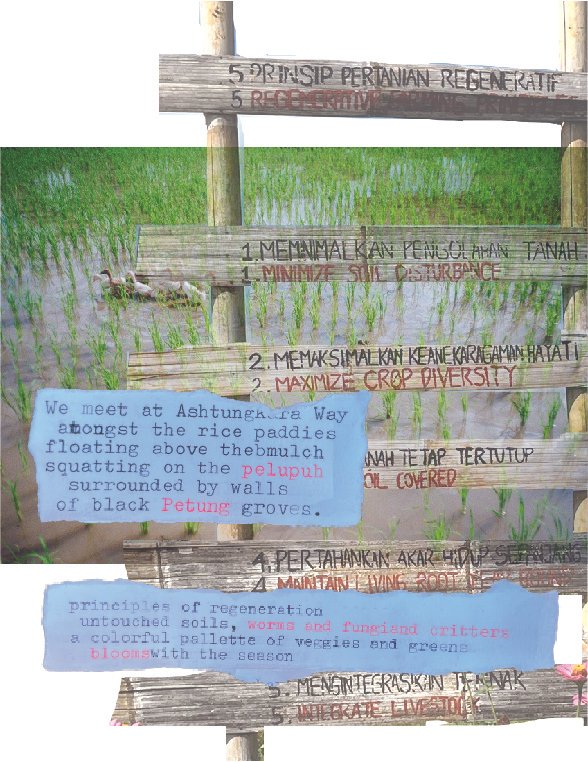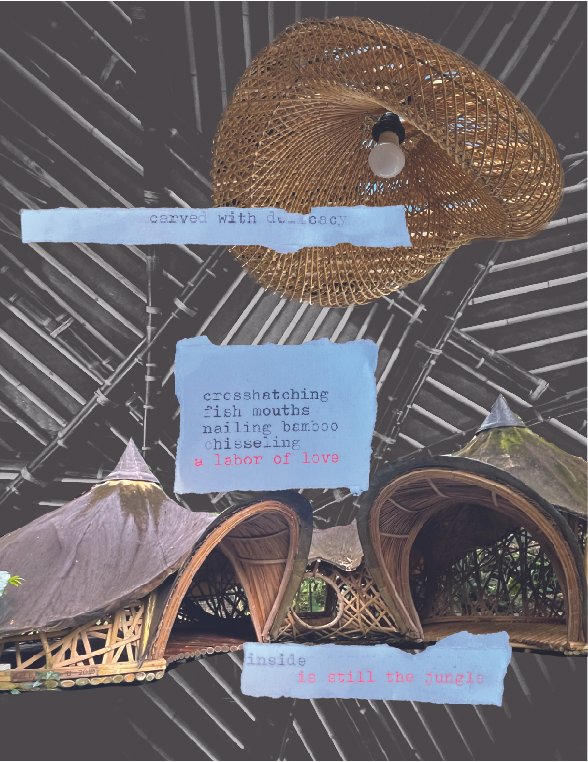Judith lee Travel Scholarship.
During the summer of 2023, I applied and was granted an undergraduate travel scholarship which funded my travels across Indonesia, to study Bamboo construction and regenerative landscape management.
Collage Exhibition at Wurster Hall, during the week of 11/13-11/17 of 2023.










Reflection
〰️
On sun
〰️
and sights
〰️
Reflection 〰️ On sun 〰️ and sights 〰️
After days of traveling, we finally landed on this rock in the middle of the Indian Ocean. As the sun rose, dawning our first day, I grasped the unexpected and extreme rawness of the island, the way the waves break on the rocks here on the temple-topped rocks. Looking out from the shell-littered beach, beyond the cascading rocks, beyond the turquoise barrels, beyond the lineup of experienced surfers – there is an inspiring nothingness except blue skies.
The beauty here feels untouched, the air here pure with every deep breath. An untouchable pulse guides the elegance of nature and the kindness of man.
The Frangipani is the famous flower of Bali. It forms a spiraling arrangement with its five petals, blending into a meditative vortex. A nucleus at which my eyes rest. Just like this gem of an island. Tranquility is what this island inspires.
The delicacy of nature and the balance of the parts here is so apparent. The jungle is an intricate yet resilient ecosystem, the footpaths are weathered with use, the cliffs tarnished with dark lichen, rocks battered by the waves, and trees bending over the steep eroding cliffs where they meet the great raw ocean. Monkeys dance on the thick branches of jungle trees, scatter across vines, and chatter on the telephone wires on the streets.
The taste and sight and sounds. Explosions to my senses, a multidimensionality I have never before experienced before. Colors of such vibrancy I never before believed possible except in neon crayons. Chirping and yapping as the birds awake with the morning sun, and barking as the monkeys discover their favorite treats: tourist sunglasses. And the tastes, exquisite textures, of fruits as obscure as raw jackfruit, stinky durian for dessert, mangosteen, soursop, rambutan, or the crisp green starfruit.
The people: they spread joy, love, creativity and their love for the Gods. The Hindu temples are ornamented in carvings and offerings decorate the sidewalks with their celebration of life.
The jungle and its stewards have rediscovered a pristine reciprocity in many locations across the island. Such as at the Shaya Jungle Kitchen, where the jungle is celebrated for what it has to give — from its buds, leaves, flowers, grasses, nuts and shells. Upon plucking and tasting our way through jungle trails and villages, filling bags with gathered goods, I realized the endless abundance of the jungle. Every part harvested was used to the fullest: stems for soups, flowers for tea, nuts for bread, roots for medicine. Everything was cooked in the kitchen, spiced to Balinese taste, and celebrated in offerings and prayer to thank the Earth for its generosity.
We enter the farm, diverging from the turquoise of the ocean, to the deep muddy green.
The roads converge at Ashtunkara Way, on a rickety small road only accessible by foot or small motorbike, in the midst of miles of soggy rice paddies. We meet at the permaculture farm, a sustainable tourism destination experimenting with pollinator gardens, sustainable agricultural production, and innovative rice production methods, including ducks for insect repellent. No crop here at this garden is segregated. Unlike the monoculture of surrounding rice paddies, this garden incorporates all aspects of a flourishing jungle ecosystem ~ flowers for pollinators, vines, bananas, trees, windbreaks, and integrative rice cultivation.
At the center of this small lot garden, floats a beautiful airy bamboo structure overlooking the horizon of windy green. This building is shared between an English school for children in the evenings and Bamboo Creative’s course during the day. This is where we met our Balinese teachers and fellow classmates every day for a week. Stooped on the plupuh floors of flattened bamboo, we learned the techniques of knife holding, chissel handling, and carving bamboo nails. Our mentor Ketut guides our hands as we carve holes and fishmouths – the two main mechanisms by which bamboo is jointed. Not once did we hold a measuring tape or crunch numbers. A bamboo stool came together by hand, measuring spacing and nails anthropometrically.
We learned the process of bamboo harvesting, treatment (from Borax bath to hair trimming to sun curing), construction techniques, and ethics and politics. During the meal breaks, we ate vegan delicacies wrapped in banana leaves, and break down the politics of bamboo, gaging opinions on BambooU, John Hardy and his jewelry business turned bamboo empire.
Upon finishing the bamboo course on the farm every afternoon, we would motorbike to a new destination, exploring other bamboo courses, construction projects and groups. So it happened that we interacted with both sides of the bamboo spectrum. Bamboo Creative which was a small cohort of inspired individuals, engaging local community to build their individual farms and houses of bamboo. And IBUKU and BambooU, larger firms with the goal of globalizing bamboo, privately teach sustainability practices, whilst continually proclaiming the inclusion of local Balinese communities.
From this contention I have stumbled upon these consensuses:
No one is completely in the right. Bamboo is barely accessible enough to Balinese people. No matter who is guiding the way, bamboo is still far oo expensive, inaccessible, and non-traditional for Balinese people to incorporate into their homes. Therefore, Balinese will foreseeably continue to build their homes in stone and brick.
The “worldwide bamboo movement” is not the end-all solution for sustainable building materials in Iceland – Brazil — Russia – India. It is well suited for some places, such as Bali, where giant Petung bamboo grows in everyone's backyard. It is most suitable for airy buildings in the rainforest where all you need is a roof. Engineered bamboo to allow for insulation or “angular” building in cities may not be the best answer but it is an interesting exploration.
The craft of Balinese bamboo construction is unique. There is a group of craftsmen, like Ketut, who are hired for their artistry all across Indonesia, and Asia, with aspirations of coming to America and building projects in cities like Las Vegas No one can hold a knife like them, no one can carve with such immeasurable precision as they can. Simon Velez in Columbia and others worldwide are also exploring bamboo construction, but the craftsmanship in Bali is unparalleled.
Lastly, how does bamboo help us give back to Mother Earth?
Like the insular Balinese family, Bamboo grows in rings surrounding its ancestors. Centered around the grandparents, the offspring sprout in the same grounds. Children can be harvested once they reach their full maturity. Bamboo is more regenerative than concrete, but processed with chemicals and salts. Once we harvest this material from nature, how can we ensure we are giving back and promoting unceasing livelihood? IBUKU answered this question by building something aesthetic, promoting visual beauty in the landscape, yoga and wellness studios, with sustainably harvested materials. Bamboo Creative promotes an indigenous-based approach to building individual homes and farms for hippies from Australia.
Perhaps the answer lies somewhere in between. Take the medium between aesthetic beauty and community engagement emphasizing indigenous values – and begin to promote accessibility and cultural connection to bamboo. As scientists, landscape architects, and designers of the future, it is up to us to ensure that these new materials and applications are holistically integrated into the existing systems and landscape.